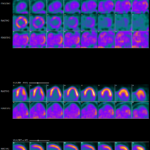Objective: Cardiac magnetic resonance imaging (MRI) has enabled the assessment of myocardial features, including tissue characteristics and functional changes, in patients with systemic lupus erythematosus (SLE). Echocardiography detects cardiac decompensation. This study was undertaken to investigate the use of cardiac MRI to explore early warning signs of silent cardiac involvement in SLE and determine treatment timing.
Methods: Clinical assessment and cardiac MRI studies were performed in 50 drug-naive patients with new-onset SLE, 60 patients with longstanding SLE and 50 healthy subjects in a three-center, prospective study.
Results: Analysis of cardiac enzymes, the presence and size of regional myocardial fibrosis, as indicated by late gadolinium enhancement, strain changes and biventricular ejection fraction did not indicate cardiac impairment in the patients with new-onset SLE. Native myocardial T1 and extracellular volume (ECV), which are extracellular matrix indices, were elevated in the patients with new-onset SLE (1,369±79 msec vs. 1,092±57 msec in the control group for native T1; 32±5% vs. 24±3% in the control group for ECV; P<0.001 for both). The elevation was independent of SLE disease activity.
Discussion & Conclusion: This study found that 1) drug-naive patients with new-onset SLE, even those with inactive disease, were likely to have silent cardiac impairment; 2) SLE patients could have impairment affecting the matrix, structure or function of the myocardium, and myocardial impairment was related to SLE disease stage; 3) native myocardial T1 values and ECV, rather than currently used clinical rheumatic and cardiac indices, could serve as early detection markers of myocardial injury before late gadolinium enhancement and functional decompensation; and 4) the right ventricle is involved in cardiac impairment prior to the left ventricle in patients without coronary artery disease. Findings for all of the cardiac indices were unrelated to SLE disease activity.
The structural and functional changes in the myocardium were related to SLE disease stage; this association demonstrated the value of early detection of myocardial involvement. Early detection of myocardial injury before the presence of LGE and functional decompensation using native myocardial T1 values and ECV might enable the selection of optimal medical treatments. Further studies with larger sample sizes would be useful for evaluating the effect of this early detection.
Excerpted and adapted from:
Guo Q, Wu L-M, Wang Z, et al. Early detection of silent myocardial impairment in drug-naive patients with new-onset systemic lupus erythematosus. Arthritis Rheumatol. 2018 Dec;70(12):2014–2024.

